Your houseplant collection depends on you for proper care and that includes choosing the best pot for your Monstera based on its needs. The pot you put it into needs to be big enough for the roots to grow freely, but small enough to prevent the soil from remaining soggy.
But those are not the only things you need to consider when choosing the right pot for your Monstera plant. The plant pot for your Monstera needs to provide stability for the plant, have drainage holes, be the right size… and, of course, it should look great as well!
So follow this guide for tips on how to choose the best pot for your Monstera plant.
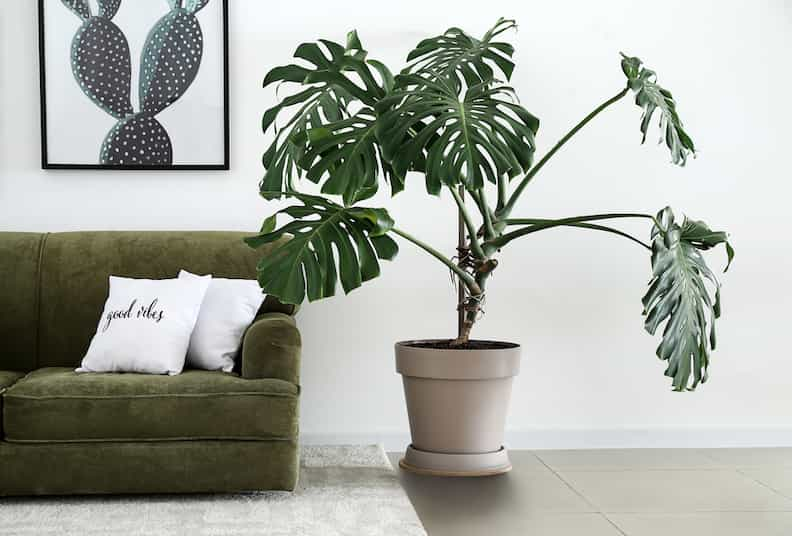
Table of Contents
What is the best pot for Monstera?
The best pot for your Monstera is one that has one to two inches of space between the roots and the edges of the plant pot. Also, because you’ll likely be adding a moss pole at some point, the pot needs to be deep enough to insert the pole and support its weight. Finally, it should have drainage holes.
While that may sound like a lot of requirements, it’s really not. That’s especially the case when you realize that a lot of plants have quite similar needs when it comes to the pot they’re placed in, so you’ll have a lot of choice.
However, in the case of Monsteras, they are prone to root rot if the soil remains soggy and doesn’t drain well. That means that while choosing a pot that looks good in your room is something to keep in mind, it’s also important to make sure it ticks other boxes too, like the following:
1. Provides one to two inches of space between the roots and pot edges
The pot you choose for your Monstera plant needs to be large enough for the roots to grow, but small enough to allow the soil to dry out between waterings. As a rule, and as just mentioned, your Monstera plant needs a pot large enough so there is one to two inches of space between the roots and the edges of the plant pot.
FYI: If you don’t want to buy a new pot for your Monstera but it’s getting too big for its current one, you could also try pruning its roots to make the root ball a smaller, better size for the pot.
Check out our article on how to prune your Monstera to see just how to do this.
The pot also needs to be large enough to support the weight of your Monstera plant to prevent it from toppling under the weight of the plant.
2. Deep enough for a support pole
The depth of your Monstera’s pot is important, too. Because you will likely be adding a Monstera moss pole or totem to the pot, you need to take the depth of the pot into consideration.
The pot needs to be deep enough to insert the pole and support its weight, too. A shallow pot may become unstable or top-heavy when you add the pole.
Generally, your pole needs to be inserted to a depth of at least seven inches to provide the stability a giant Monstera plant needs.
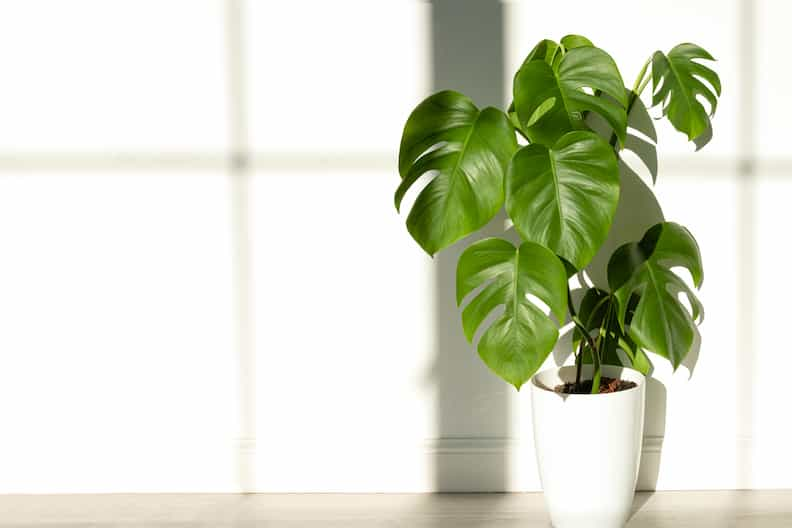
3. Made from material that suits your watering habits
The material the pot is made of makes a significant difference in how quickly the soil dries. Terracotta and other porous pots dry out quickly as they whisk moisture from the soil. The soil in plastic or ceramic pots dries more slowly because there is nowhere for the moisture to go.
If you tend to over water your houseplants, a porous pot, like terracotta, may be an excellent choice because they help prevent soggy soil – although it’s worth keeping in mind that the best soil for Monstera is definitely well-draining mix, meaning you shouldn’t really need a terracotta pot to help you with that. However, if you lean towards neglecting your plants, and they get overly dry between waterings, plastic, glazed terracotta, or ceramic pots may be a better choice.
4. Looks aesthetically pleasing
Just because your Monstera plant doesn’t care what its pot looks like doesn’t mean you don’t. Many plant lovers like to match their plant pots to their décor to create a pleasing display.
One issue that can arise is that many large decorative pots lack drainage holes. That’s okay too, though, as there are ways to compensate for what your decorative pots lack in the way of drainage.
Using the decorative pot as a cache pot is always an option. To do this you simply grow the Monstera plant in a simple plastic pot (the florist pot will do) nestled inside the decorative pot. This option can also work well if you’re looking to grow your Monstera in water but don’t like the look of a jug or glass vase.
When watering your Monstera, the water will drain through the soil and out the drainage holes in the plastic pot. The cache pot prevents water from spilling on your floor and making a mess.
You do need to watch out for standing water in the bottom of the cache pot, though. Standing water in the bottom of the cache pot can cause issues with proper drainage and keep the soil moist for too long. Treat the cache pot like a saucer and empty it after watering to prevent issues with soggy soil.
5. Has drainage holes
Monstera plants need well-drained soil to thrive. While you will need to provide them with a good soil mix it doesn’t end there. To drain well, the soil needs to be in a pot with drainage holes in the bottom. This gives the water somewhere to go when it drains through the soil.
As mentioned above, either use a pot with drainage holes (or drill some yourself) or use the desired pot as a cache pot with a more suitable pot with drainage holes nestled inside it, so it is hidden from view.
How to choose the best pot for your Monstera
Choose the best pot for your Monstera by considering the size of your plant and how it’s being grown. That is, in addition to considering the width of the pot, a climbing Monstera that needs a support pole will need a pot that’s deep enough to support this. A trailing or vining Monstera variety can have a shallower pot.
As you can probably tell, choosing the best pot for your Monstera plant isn’t difficult, but it does call for some consideration. Consider these aspects of pot selection when choosing a pot for your Monstera:
Plant size
A small Monstera plant can live in the same pot for several years. It will do fine in the florist pot you bought it in. It does not need a large pot, yet.
A large Monstera plant requires a bigger pot to provide room for the roots and to provide support for the plant. If your Monstera plant is reaching for the sky on a moss-covered pole, be sure the pot is large enough to support the weight without toppling.
Growing habit
Monstera plants are vining or climbing tropical plants. Many plant lovers grow them as climbers and provide poles or totems to train them to grow upward. But that isn’t the only way to grow a Monstera plant.
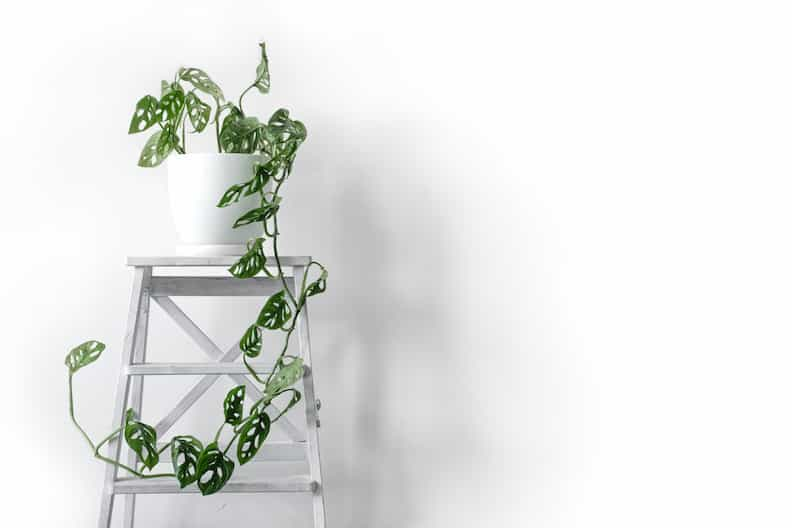
Many Monstera plants can be grown as a trailing or vining plant, too. These plants can be grown in a hanging plant pot, baskets, or displayed on a raised plant stand.
Plants that are allowed to vine or cascade over the sides of pots can thrive in a shorter pot as they don’t need to support the weight of a large climber.
What size pots do Monstera like?
Monstera plants like pots that give their roots room to grow and will suffer if the pot is too small. However, Monstera plants in pots that are too big for their needs may suffer because the excess soil doesn’t drain or dry out quickly enough.
It’s a bit of a Goldilocks dilemma. After all, a pot that is too small will stunt the plant’s growth and prevent it from growing as it should. But a pot that’s too big could kill your plant due to the pot holding too much moisture, leading to root rot in your Monstera.
Monstera pot size guide
Here are some broad factors that can help serve as a Monstera pot size guide for you:
- How big is the root ball? When it comes to the best pot for Monstera, there should be one to two inches of space between the roots and the edges of the plant pot. This means that you may actually need to check the roots before choosing your pot, just to know the size you need.
- Does your Monstera need a support pole? A climbing Monstera needs a moss pole or other totem to help hold itself up. If yours is growing like that, you’ll need a pot that’s deep enough to allow the pole to stand in the pot.
- Is your Monstera growing as a trailing or vining plant? Monsteras can be beautiful as they trail out of a pot, allowing their vines to spill over towards the ground. And this inevitably means that the pot can be shallower given that it doesn’t need to hold a support pole.
- Will the pot directly hold your Monstera or will it be a “cache pot”? Often, people choose to keep their Monstera in a plain plastic pot and then put that pot in a more decorative one, with the outside pot being known as a “cache pot”. If that’s the case here, the cache pot will need to be big enough to hold the inside pot.
Do Monstera like small pots?
Monstera like relatively small pots, as pots that are too big can lead to overwatering. Ideally, a pot will allow for 1 to 2 inches of soil between the root ball of the plant and the sides of the plant pot to give your Monstera room to grow without having too much space that can lead to problems.
Signs your Monstera pot is too small
- Soil dries too quickly. When the pot is too small for your Monstera plants, the roots may have difficulty getting enough water to nourish them. Because there is less soil, it tends to dry out quickly leaving your Monstera plant struggling to get the moisture it needs.
- Roots appear on the top of the soil. When roots run out of room in the soil, they may try to find moisture and nutrients by growing toward the surface of the soil. If you notice roots starting to show at the top of the soil, the plant pot is too small.
- Roots grow through drainage holes. If your Monstera roots are growing out of the pot through the drainage holes in the bottom, it could be time to move it to a different pot. They may even begin to twine around the base of the pot between the pot and the saucer.
- Growth slows down. When your plant doesn’t have room for its roots to grow, you may be faced with a root bound Monstera. Root bound plants struggle to get the moisture and nutrients they need from the soil but may not get what they need. That causes the plant’s growth to slow down as it doesn’t have the resources it needs to flourish.
- Plants are unstable. If your Monstera plant becomes top-heavy or tipsy and tends to jostle to the side whenever it is disturbed, the plant pot is too small to support the weight of the plant.
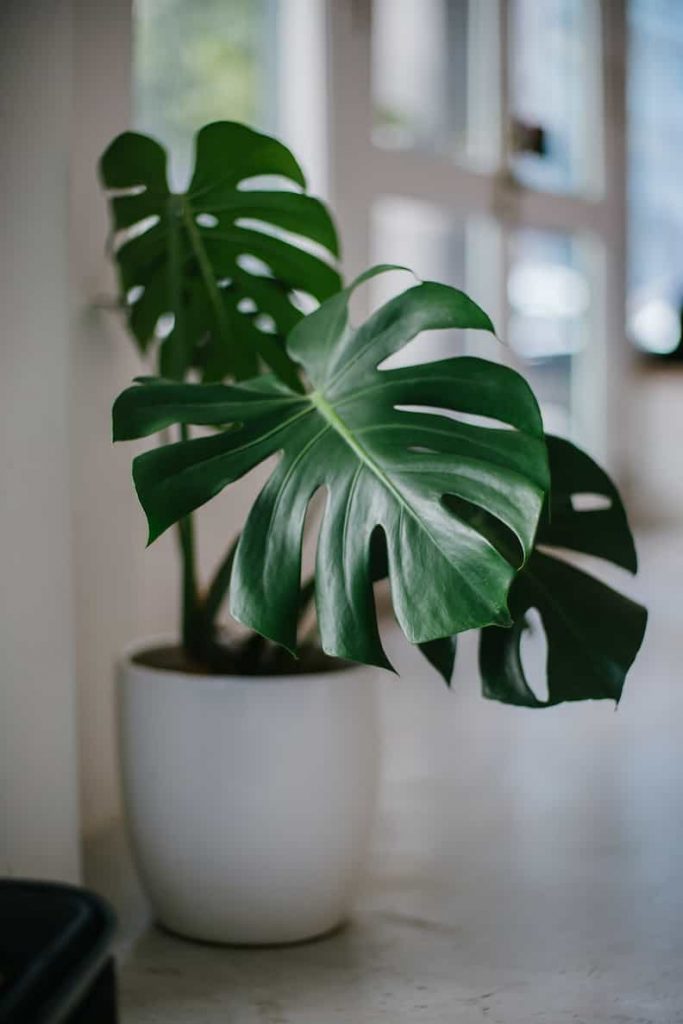
Signs your Monstera pot is too big
- The soil stays wet and doesn’t dry out. Large pots mean there is more room for soil. While good soil is important to your plant’s growth, too much of it can pose a risk, too. Too much soil in the pot means that when your plant is watered there is more water than your plant can use. This causes the soil to stay wet for too long leading to issues with root rot and other fungal diseases.
- Soil is too loose or is compacted. A large pot filled with excess soil also makes it difficult to keep the soil firm around the roots. It can also become compacted with repeated watering. Overall, soil in a pot that is too big for the plant will suffer.
Do Monsteras like big pots?
Monsteras like pots that provide enough room for their roots to grow. In practical terms, that means there should be 1 to 2 inches of soil between the root ball of the plant and the sides of the plant pot.
If your Monstera plant becomes root bound and overgrows its current pot, you will need to give it a larger pot when you repot it. Plant pot size is noted in even numbers that represent the diameter of the pot in inches.
When repotting a Monstera plant choose the next largest size in a pot. For example, if your Monstera outgrows its 8-inch pot, choose a 10-inch pot when you repot it.
What kind of pots do Monsteras like?
Monsteras don’t really care what kind of pot you plant them in as long as it has room for the roots to grow and the soil drains well. You can choose any pot you’d like, but it is up to you to make sure your Monstera’s needs are met.
Do Monsteras need drainage holes?
Because Monsteras need soil that is evenly moist and suffers if it remains wet, they need a plant pot with drainage holes. Drainage holes allow excess water to run through the soil when you water your Monstera plant. Good drainage is necessary to prevent soggy soil.
Bear in mind that if your plant pot does not have drainage holes you can drill holes yourself with the appropriate drill bits. You can also use your decorative pot as a cache pot and grow your plant in a plain plastic pot tucked inside the cache pot.
Is terracotta good for Monstera?
Terracotta is good for Monstera, as long as you understand how the different types of terracotta pots impact how much moisture the plant soil holds. That way, you’ll avoid any problems arising from accidentally overwatering your Monstera plant.
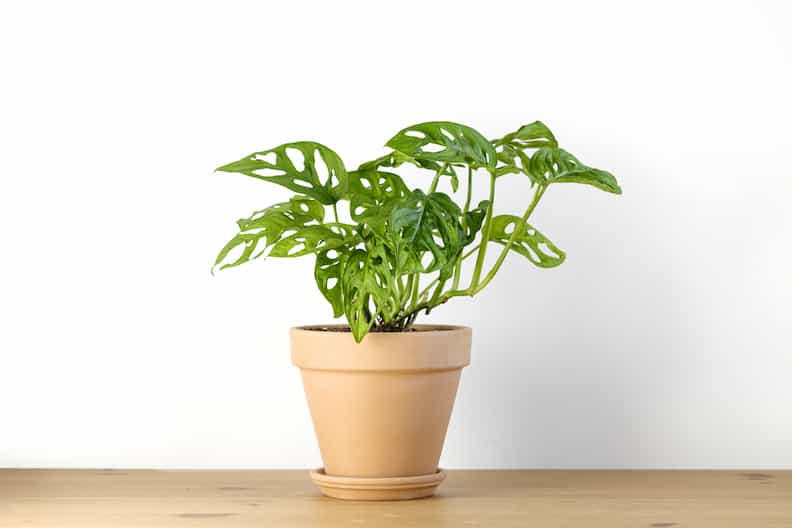
Many plant lovers choose to keep their Monstera in a terracotta pot because they blend with any décor and add visual appeal. Terracotta comes in two states: glazed and unglazed.
- Glazed Terracotta Pots: Glazed terracotta pots have been sealed with either clear or decorative glaze. These terracotta pots are non-porous and function similarly to a plastic or ceramic pot. They hold in moisture and keep the soil moist for a longer time. The danger of non-porous pots is that you run the risk of soggy soil if you tend to overwater your plants. Soggy soil can lead to root rot and other diseases that pose a risk to your Monstera plants.
- Unglazed Terracotta Pots: Unglazed terracotta pots have not been sealed and are porous. Water from the soil can be absorbed by the pot and then released into the air. Porous pots can cause the soil to dry out quickly leaving your Monstera plant scrounging for moisture. If you tend to water your Monstera too often, an unglazed terracotta pot may be a good choice for you as it will help you prevent issues with over watering.
So can Monsteras be potted in terracotta?
Monstera plants thrive in any pot that gives the roots enough room to grow and has well-drained soil. Both glazed and unglazed terracotta pots are good choices for Monstera plants once you understand the subtle nuances of using them.
Unglazed pots dry out quicker and reduce the risks associated with wet, soggy soil. Glazed terracotta pots keep the soil moist longer. Each can be either an advantage or disadvantage depending on your plant care habits.
In summary: If you tend to underwater your plants, choose glazed terracotta. If you’re a little more heavy-handed with the watering can go with unglazed terracotta.
Either way, your Monstera will thrive in terracotta as long as its needs are met.
What to use for a large plant pot for Monstera?
You can use nearly any container as a pot for your Monstera plant by using the double pot or cache pot technique. With this technique, you can grow your Monstera plant in an unattractive pot, such as the florist pot or other simple plastic pot, and conceal it inside a decorative container.
This means that your decorative pot or container isn’t limited to only those with drainage holes. Consider these options for large pots for your Monstera plant.
Large urns
There is something mysterious and exotic about towering urns with decorative designs. They create a stunning display when used as cache pots for your Monstera plants. You can buy urns at your local garden center, but don’t overlook those sold in discount stores.
Large plastic replicas of ancient urns can often be purchased for a minimal fee at a discount store (or even the dollar store). You may need to paint them to match your décor, but the results will make your efforts worthwhile.
Decorative bowls
Like decorative urns, decorative bowls also make an excellent cache pot for your Monstera plants. Look for bowls at antique or estate sales, yard sales, and in discount stores. Mix and match the size and color to add a splash of color to your Monstera collection.
Decorative tubs
Whether you prefer the look of a wooden tub, or like the country charm of an old washtub, there is one in the right size and shape to show off your Monstera plants in style. Use them as a cache pot for a large Monstera plant or gather several small pots together to fill a decorative tub.
As an added bonus, you can add a pebble tray in the bottom of the tub to increase the humidity around your Monstera plants.
Barrels
Barrels come in all shapes and sizes and make a dramatic planter for your Monstera plant. You can choose from whiskey barrel planters, antique nail barrels or even a standard potato barrel for a unique pot for your Monstera plant.
Check yard sales and estate sales for barrels you can use as cache pots and create an unusual and eye-catching display with your Monstera plants.
Choosing a plant pot for your Monstera plant doesn’t need to be a chore. As long as you make sure the plants have well-drained soil and the support your plants need there is no limit to what you can use for a pot. If you are the adventuresome sort, think outside the box and choose containers that express your personal style and turn them into large plant pots for your Monstera plants.
